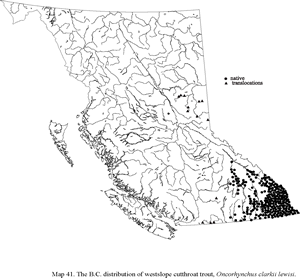The native range of the westslope cutthroat (ssp.
lewisi) is the southeast part of the province (especially the Kootenay drainage system). Generally, its life history is not as complex as the coastal subspecies. There are, however, “dwarf” headwater populations and also some in high mountain lakes. At one time, some of these small-bodied populations were recognized as separate subspecies but there is no good evidence that they warrant taxonomic recognition. The biggest threat to the westslope cutthroat is the introduction of rainbow trout into areas where westslope cutthroat are native. Such introductions inevitably lead to massive hybridization and the loss of the “pure” westslope genome. The process has gone so far in the northwestern U.S. that pure westslope cutthroats are almost gone. In B.C., there are enough isolated populations above barriers that “pure” populations probably will survive; however, further introductions of rainbows into areas that are occupied by westslope cutthroat would be ecological vandalism. The few headwater populations in some Eagle River tributaries are the only native populations of westslope cutthroat in the Fraser River system. They should be protected. This subspecies has been transplanted to lakes in the Peace River Drainage.
Source: Information provided by Don McPhail for E-Fauna BC.
McPhail (2007) provides the following range description for this subspecies: "A complex series of allopatric subspecies of cutthroat trout are distributed along the eastern slope of the Continental Divide from New Mexico north to southwestern Alberta, and west of the continental divide from the eastern slope of the Sierra Nevadas, throughout the basin and range country of California, Arizona, Nevada, and Utah north into southeastern British Columbia. The subspecies at the northern end of this complex series of interior cutthroat trout is the westslope cutthroat. Its range includes most of the upper Columbia drainage system (excluding the Snake River system above Shoshone Falls) and disjunct populations in the upper John Day River (Oregon) and along the eastern slope of the Cascade Mountains in Washington (Behnke 2002; Williams 1999). Some of these disjunct populations may be the result of early hatchery plantings. It is also native in foothills rivers and streams tributary to the South Saskatchewan River in southwestern Alberta (Nelson and Paetz 1992)."
